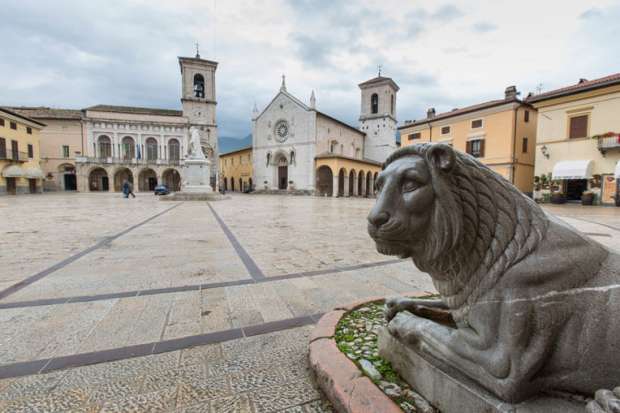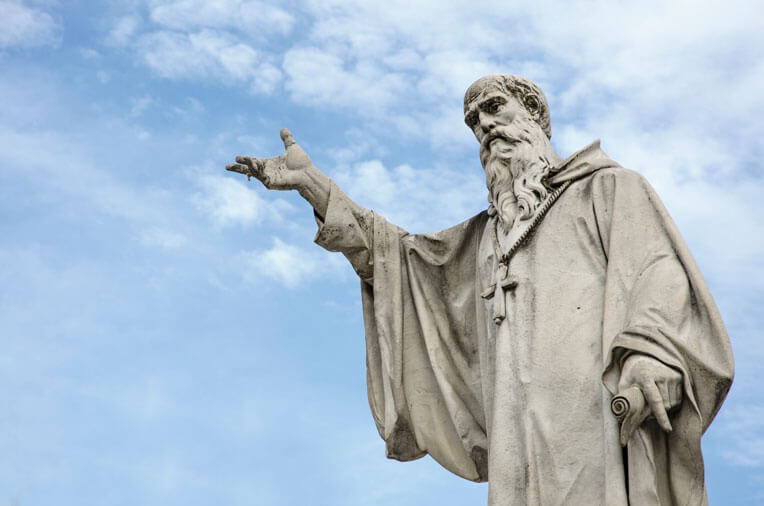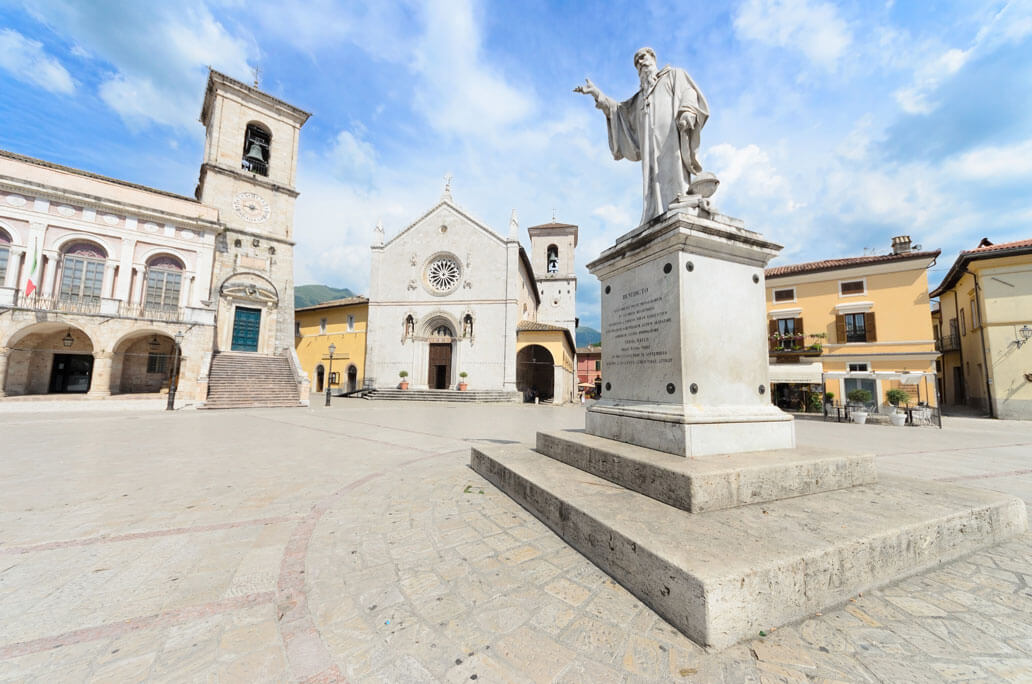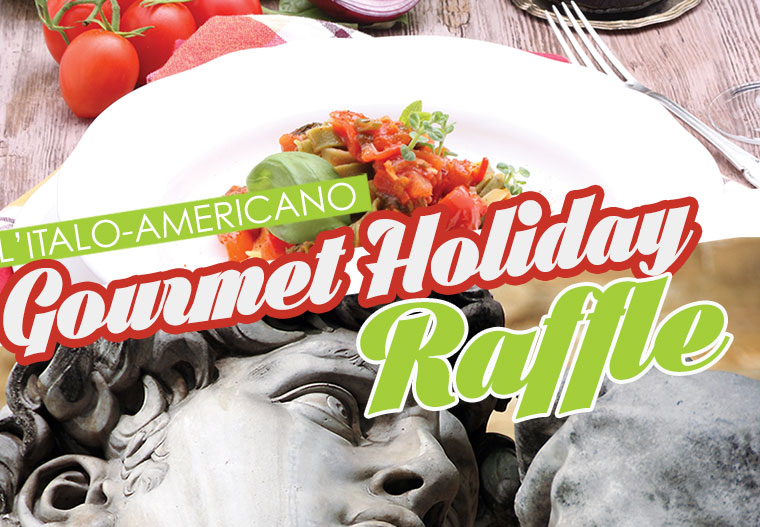Norcia: a cradle of tradition and art, a symbol of western culture, home to Saint Benedict father of monasticism and patron saint of Europe.
Norcia: medieval alleys and stone, “norcinerie” with their prosciutto and wild boar salame, the peaceful fragrance of Umbrian air. Of this town, after last October’s earthquake, very little remains standing: also its symbol, the Basilica of Saint Benedict, erected on the very spot the natal house of the saint was thought to have been, was reduced to a heap of pitiful rubble.
Locals have learnt to call it “il mostro,” the monster, because just like the frightful creatures of our childhood nightmares, the earthquake comes without any announcement and, in spite of all the efforts of science, it blindly destroys. Its presence is heavily felt even when the earth is still, just like the thought of the old evil witch living under our beds used to hunt us also during the day when we were children. Very little could be done to avoid completely this tragedy: Nature is mighty and we are, in the end, only one of its many creatures.

The earthquake damaged the very heart of central Italy. It hurt its people, who lost a home and all their possessions; it hurt the area’s economy, which has been thriving thanks to tourism and the fine food and wine industries; it hurt the whole of Italy, for the immense artistic and cultural loss those areas had to endure.
An important Italian daily, La Repubblica, called the area hit by earthquake “the land of broken belfries:” famous is that of Amatrice, still marking the time of the fatal August, 24th quake, but the artistically relevant buildings put at risk are many more.
Symbol of them all is certainly the already mentioned Basilica of Saint Benedict in Norcia, yet the list is endless: always in Norcia, Saint Mary’s cathedral, the church of Saint Mary of Sorrows and that of Saint Rita have been obliterated. The cathedral of Rieti, beautiful example of romanic architecture outside and of baroque opulence inside, has been precautionarily closed. In the region of Marche, the Palazzo Municipale of Castel Raimondo is considered unfit for use and in Montegallo, the church of Santa Maria in Pantano, which dated back to the year 800, has painfully crumbled down.
Orvieto’s Duomo, one of Italy’s gothic masterpieces, has been closed down to make sure its structure has not been damaged: thankfully this building, at least, has been declared entirely safe. The frightful hand of the earthquake has even reached Rome where damages, albeit minor, to the churches of Saint’Yves alla Sapienza and its Borromini cupola, of Saint Eustache, a stone’s throw away from the Pantheon, and even to the basilica of Saint Paul outside the Walls and the Coliseum were recorded.
Art has paid a painful toll to “il mostro”, just as people did.
A lot can be done now, however, to support reconstruction and bring back life to normality, and a lot has been done already. Shortly after the quake, famous Italian textile businessman Brunello Cucinelli declared he wishes to finance Saint Benedict’s basilica reconstruction and bring his support to the community.
The Protezione Civile and the Vigili del Fuoco (the Italian Fire Brigade, which is about to receive a Medaglia d’Oro al Valor Civile for its work and courage after the earthquakes of August and October) have been constantly at work to rescue, protect and help people remaining safe.
Thanks to their dedication, and that of hundreds of thousands of people from Italy and all over the world who donated to Umbria and Marche with an open hearth, the reconstruction process has began, in spite of the Winter colds.
That first, bleak post-earthquake desolation has turned today, at least in part, into an afflatus of hope. People have been trying to return to normality, schools have opened again, shops and pharmacies have been set up in the small pre-fab buildings locals have now learnt to call home. Even the economy has somehow slowly taken up again, thanks to one of Umbria, Lazio and Marche’s excellences: food and wine.
The trend was launched last August when restaurants all over the world started proposing “amatriciana” on their menu to collect funds destined to reconstruction. When Norcia was hit, it was once again its notorious culinary products, sold all over the world online and by phone (be weary of scams!) to support financially those first attempts at rescue and reconstruction.

This should not come as a surprise, as central Italian cuisine and products are among the most delicious and best known all over the world: cheeses and cold cuts like pecorino, guanciale, capocollo, salame, but also earthy produce like lentils of Castelluccio and chickpeas of Colfiorito, have been part of the Marche, Lazio and Umbria tradition for centuries. Today, central Italian food is no longer simply something good to eat, it has become a symbol of hope and of this lands’ resilience and strength.
A lot has been done to help Amatrice, Norcia, Accumoli and all the other villages and towns hit by the quake, yet so much more still needs to be done. Keeping awareness high and donating, always through reputable and secure channels, remains essential to allow people to conquer back their independence and their stability and to permit the restoration and reconstruction of the damaged artistic patrimony.
Italy has been offering her heart to the world for millennia through her art, traditions and culture: now, it may be the right time to give something back.




























